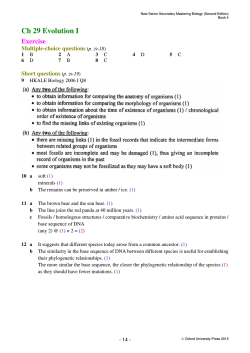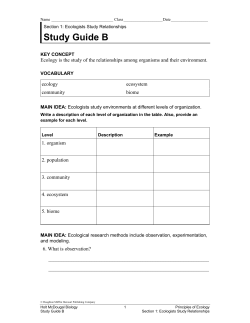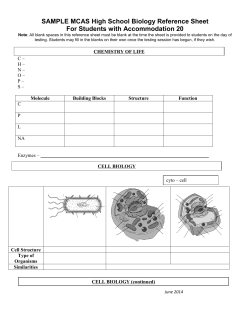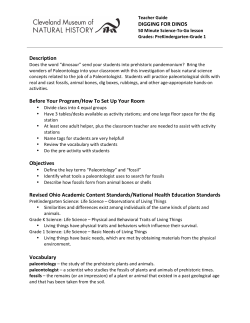
book here
Name ______________________________ Class ___________________ Date __________________ Wed, March 26th: Correct 10.3 WS/ 10.4-10.5 notes*/ 10.4-10.5 SG* Sec. 10.4 KEY CONCEPT Evidence of common ancestry among species comes from many sources. Evidence for evolution in Darwin’s time came from several sources. • • • _________ provide evidence of ____________. Fossils in ________ layers are more ____________ than those in the upper layers. The study of _____________ provides evidence of evolution. – – • • populations can show __________ from one island to another ____________ provides evidence of evolution. – – __________ larvae, _____________ adult body forms ________ embryos, _________ organisms The study of ___________ provides evidence of evolution. – – • _________ species most closely resemble nearest ____________ species _______________ structures are similar in structure but different in function. Homologous structures are evidence of a ________ ____________. The study of anatomy provides evidence of evolution. © Houghton Mifflin Harcourt Publishing Company Holt McDougal Biology Study Guide A 1 Principles of Evolution Section 4: Evidence of Evolution Name ______________________________ Class ___________________ Date __________________ – – _____________ structures have a similar function. Analogous structures are _____ evidence of a common ancestor. Sec. 10.5 KEY CONCEPT New technology is furthering our understanding of evolution. Fossils provide a record of evolution. • • ______________ is the study of fossils or extinct organisms. Paleontology provides __________ to support ____________. Molecular and genetic evidence support fossil and anatomical evidence. • • • ______________ are sequences providing evidence of evolution. – – – ___ longer _____________ carried along with ____________ _____ can be clues to a __________ ___________ _____ _______ indicate a very distant common ancestor. – – control the ______________ of specific structures found in many organisms _________ comparisons, or _____________ fingerprinting reveals similarities among cell types of different organisms. Evolution unites all fields of biology. © Houghton Mifflin Harcourt Publishing Company Holt McDougal Biology Study Guide A 2 Principles of Evolution Section 4: Evidence of Evolution Name ______________________________ Class ___________________ Date __________________ • • Scientists from many fields ____________ to the understanding of evolution. The _______ ____________ of evolution are used in many scientific fields. © Houghton Mifflin Harcourt Publishing Company Holt McDougal Biology Study Guide A 3 Principles of Evolution Section 4: Evidence of Evolution Name ______________________________ Class ___________________ Date __________________ Section 10.4: Evidence of Evolution Study Guide KEY CONCEPT Evidence of common ancestry among species comes from many sources. VOCABULARY biogeography analogous structure homologous structure vestigial structure MAIN IDEA: Evidence for evolution in Darwin’s time came from several sources. anatomy embryology fossils geography In the diagram below, fill in the type of evidence below the examples. 1. Traces of ancient animals are found in rock layers. ______________________ 2. Species in one area may match species in another area that is separate but still nearby. ______________________ Evidence for evolution in Darwin’s time came from several sources. 3. Two different species may have larvae that are very similar. ______________________ 4. The body parts of different species may have homologous structures. ______________________ MAIN IDEA: Structural patterns are clues to the history of a species. Choose the word or phrase that best completes the sentence or answers the question. 5. Pelvic bones in snakes are an example of a(n) a. homologous structure. b. analogous structure. c. vestigial structure. d. fossil. © Houghton Mifflin Harcourt Publishing Company Holt McDougal Biology Study Guide A 4 Principles of Evolution Section 4: Evidence of Evolution Name ______________________________ Class ___________________ Date __________________ Study Guide A continued 6. What conclusion can you draw from the fact that many modern whale species have vestigial pelvic and leg bones? a. The ancestors of whales may have been land mammals. b. Whales could walk if they wanted to. c. Whales are preparing to evolve into land mammals. d. Some day whales will be able to walk and will have legs. Vocabulary Check Fill in the blank with the correct phrase from the box. analogous structure homologous structure vestigial structure _______________ 7. Feature that is similar in structure in different organisms but has different functions _______________ 8. Feature that performs a similar function in different organisms but is not similar in origin _______________ 9. Feature that is not evidence of a common ancestor _______________ 10. Remnant of an organ or structure that had a function in an early ancestor _______________ 11. Examples include the wing of a bat and the hand of a human _______________ 12. Examples include the wing of a bird and the wing of an insect _______________ 13. Examples include the wing of an ostrich and the appendix of a human Sketch it Out Use Figure 4.4 to sketch a skeleton of a human hand next to the whale fin skeleton shown below. Draw lines to match the groups of bones that are homologous for these two structures. A B C D © Houghton Mifflin Harcourt Publishing Company Holt McDougal Biology Study Guide A 5 Principles of Evolution Section 4: Evidence of Evolution Name ______________________________ Class __________________ Date __________________ Section 10.5: Evolutionary Biology Today Study Guide KEY CONCEPT New technology is furthering our understanding of evolution. VOCABULARY paleontology MAIN IDEA: Fossils provide a record of evolution. Choose the best answer for the question. 1. What is the study of fossils and extinct organisms called? a. paleontology b. geology c. biology d. archeology 2. What is a “missing link” in the fossil record? a. a fossil that contradicts the theory of evolution b. a transitional fossil that shows how two species are connected c. a fossil that is physically impossible and cannot exist d. a fossil that shows a vestigial structure 3. Why are transitional fossils important? a. They show that even very ancient fossils can be found in old seabeds. b. They show that artificial selection was being practiced even in ancient times. c. They show that there are links between ancient and modern species. d. They show that the fossil record is constantly growing and being updated. © Houghton Mifflin Harcourt Publishing Company Holt McDougal Biology Study Guide A 6 Principles of Evolution Section 4: Evidence of Evolution Name ______________________________ Class __________________ Date __________________ Study Guide A continued MAIN IDEA: Molecular and genetic evidence support fossil and anatomical evidence. Match each concept with its contribution to evolutionary theory. DNA sequence analysis protein comparisons homeobox genes pseudogenes Molecular Evidence Contribution to Evolutionary Theory 4. The more related two organisms are, the more similar their DNA will be. 5. Vestigial genetic structures that are carried along with functional DNA 6. Sequences of genes that control the development of specific structures 7. The basis of molecular fingerprinting, which compares proteins among cell types MAIN IDEA: Evolution unites all fields of biology. Choose whether the statement is true or false. 8. true / false Scientists are still actively studying evolution through natural selection. 9. true / false Genetic evidence shows that whales never had ancestors living on land. 10. true / false The principles of evolution also affect the fields of medicine, geology, geography, chemistry, and ecology. © Houghton Mifflin Harcourt Publishing Company Holt McDougal Biology Study Guide A 7 Principles of Evolution Section 4: Evidence of Evolution Name ______________________________ Class __________________ Date __________________ Study Guide A continued Vocabulary Check Choose whether the statement is true or false. 11. true / false Paleontologists can never find out anything new. 12. true / false The study of fossils can help us to understand how evolution occurs. Sketch it Out Look at the fossil evidence of whale evolution shown in Figure 5.3 in this section or your textbook. Sketch one part of the skeletons (such as the skull, forelimbs, hindlimbs, or ribcages) of each of th of the whale ancestors. © Houghton Mifflin Harcourt Publishing Company Holt McDougal Biology Study Guide A 8 Principles of Evolution Section 4: Evidence of Evolution Name ______________________________ Class __________________ Date __________________ © Houghton Mifflin Harcourt Publishing Company Holt McDougal Biology Study Guide A 9 Principles of Evolution Section 4: Evidence of Evolution
© Copyright 2025



















